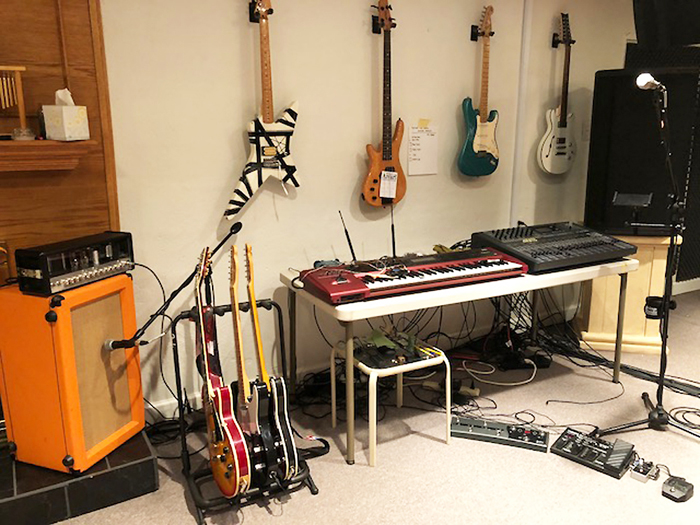
More This, More That
There were two IEM transmitters, but their current location on top of the mains troubled me because of all the RF radiation that’s probably flying out of the class D amplifiers inside the loudspeakers, and also because the bandleader told me that the receivers actually vibrated off and fell during a rehearsal. I moved them to a nearby table, properly oriented the antennas, and set the display names on each unit: “Band” on one and the lead singer’s name on the other. This is much easier to identify than trying to remember frequencies.
I set up the stereo mixes on the board and routed them to the proper outputs. Then I cabled up all of the mics, keeping all the runs clean and uniform around the perimeter of the room so the band won’t be stepping all over them. I started with input 1 (kick) and worked all the way down the desk. In the existing configuration, there were a few unused faders on the first layer, and the band inputs spilled over onto the second layer. I shifted the inputs down to fill the gaps so the band won’t have to bank the desk to make adjustments.
Once all of the mics were coming up, I went back and set gain, high-pass filters and basic EQ to get the mics sounding good though the mains. I adjusted the mic placement on the guitar amps, getting closer to help reduce bleed. I called in the bandleader and worked with him to get guitar and vocal tones through the mains. The satisfying bit was how little EQ was needed on the inputs due to the properly tuned and configured PA system.
I made some very slight adjustments to the angle of the vocal mics (some cardioid, some supercardioid) to maximize rejection of the nearby PA loudspeakers, and slightly panned each vocal to the opposite side of the stereo field to buy a little more headroom. The system was surprisingly stable at high gain, with only a slight ring around 1.25 kHz on one vocal mic. I used the onboard graphic EQ to notch that frequency out of the adjacent side of the PA, and all was well.
PA mix taken care of, we moved to the auxiliary mixes. Vocals were added to the overhead fill monitors, and then we set up the drummer’s mix with barebones kick and vocals. The vocal fill wedges are mounted on the ceiling between the mains, and so are effectively part of the PA, and thus their mix is post-fader. The drummer’s fill is pre-fader, because he’s in a semi-isolated location and his monitoring needs are somewhat unrelated.

Only Have Ears For You
Then we both put in some IEMs and built up a band mix. I configured the mix as post-fader so any changes the band makes to their levels will be reflected both in their ears and in the PA.
Use of the full stereo field is very important for clear, comfortable in-ears mixes. There’s two electric guitars and an acoustic, so I matched their panning in the IEMs with their physical positions in the room: electrics left and right, acoustic down the center.
Since IEMs isolate the wearer from the natural reverberance of the room, hearing just the close-miked inputs can create a feeling of cramped discomfort. I used a short ambient room effect and a medium hall reverb to open the vocals up a bit in the IEMs, and a third reverb for a little space on the drums. If this wasn’t enough, I had plans to put up a pair of ambient mics in the room, but luckily the bandleader found the mix satisfactory.
I copied this band IEM mix contributions to the lead vocalist’s mix as a starting point, then pushed her own vocal a bit more. After she tried it out, we made a few minor adjustments until she felt more comfortable.
I couldn’t stay for rehearsal, but I did check in one-on-one with the band members afterwards. They all said their sound was greatly improved, and had just a few requests. The drummer wanted a little more attack on the kick, which I solved by aiming the kick mic a little more directly at the beater attack area on the drum and boosting slightly around 4 kHz.
Both guitarists said they couldn’t hear themselves very clearly. This is common when a signal is panned to one side of the mix, because it’s only coming out of one ear. Human hearing uses two mechanisms to localize a sound source in the horizontal plane: interaural level difference (ILD) and interaural time difference (ITD). Basically if a sound is earlier or louder at one ear, our brain thinks it came from that side. This works great in the real world, but the pan knobs on our consoles only change the balance level balance, not arrival time.
We can create a more immersive panning effect by using both the ILD and ITD mechanisms. I created a second channel on the console for each electric guitar, panned to the opposite side, attenuated by about 8 dB and delayed by about 10 milliseconds. Now the guitars are both louder and earlier in the desired ear, so we still localize them off to the side, but with a much greater perceived width. After these changes, the guitarists felt that they were able to hear themselves much better.
Although it was a ton of work, I think my decision to rebuild the whole system was the right one. All of the musicians are happy, and going forward it will be much easier for them and the engineers alike to make the required adjustments. I’ll call this one a success.
